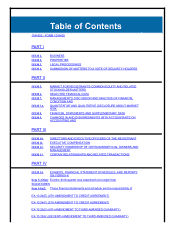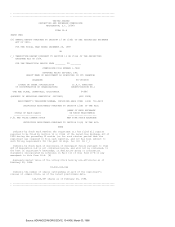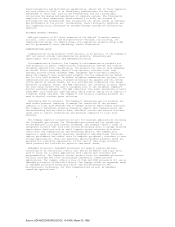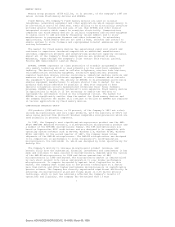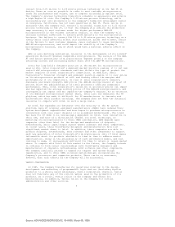AMD 1997 Annual Report Download - page 10
Download and view the complete annual report
Please find page 10 of the 1997 AMD annual report below. You can navigate through the pages in the report by either clicking on the pages listed below, or by using the keyword search tool below to find specific information within the annual report.MEMORY GROUP
Memory Group products ($724 million, or 31 percent, of the Company's 1997 net
sales) include Flash memory devices and EPROMs.
Flash Memory. The Company's Flash memory devices are used in cellular
telephones, networking equipment and other applications which require memory to
be non-volatile and to be rewritten. Their ability to be electrically rewritten
provides greater flexibility and ease of use than EPROMs and other similar
integrated circuits which cannot be rewritten electrically. Communications
companies use Flash memory devices in cellular telephones and related equipment
to enable users to add and modify frequently called numbers and to allow
manufacturers to preprogram firmware and other information. In networking
applications, Flash memory devices are used in hubs, switches and routers to
enable systems to store firmware and reprogrammed Internet addresses and other
routing information.
The market for Flash memory devices has experienced rapid unit growth and
continues to experience increased competition as additional manufacturers
introduce competitive products and industry-wide production capacity increases.
Almost all of the Company's Flash memory devices are produced in Aizu-
Wakamatsu, Japan through the Company's joint venture with Fujitsu Limited,
Fujitsu AMD Semiconductor Limited (FASL).
EPROMs. EPROMs represent an older generation of erasable programmable read-
only memory technology which is used primarily in the electronic equipment
industry. The devices are used in cellular telephones, wireless base stations,
telecommunication switching equipment, automotive applications, personal
computer hard disk drives, printer controllers, industrial machine controls and
numerous other types of electronic equipment to store firmware which controls
the equipment's operation. The ability of EPROMs to be programmed electrically
enables equipment manufacturers to achieve shorter time to market for new
products than would otherwise be possible if they were required to have
specific integrated circuits manufactured containing their final firmware
programs. EPROMs are generally preferred to more expensive Flash memory devices
in applications in which it is not necessary to enable the end user to
reprogram the information stored on the integrated circuit. The market for
EPROMs is significantly smaller than the market for Flash memory devices and
the Company believes the market will continue to decline as EPROMs are replaced
in various applications by Flash memory devices.
COMPUTATION PRODUCTS GROUP
CPG products ($682 million, or 29 percent, of the Company's 1997 net sales)
include microprocessors and core logic products, with the majority of CPG's net
sales being derived from Microsoft Windows compatible microprocessors which are
used primarily in personal computers.
In 1997, the Company's most significant microprocessor product was the AMD-
K6(R) MMX(TM) Enhanced Processor, a sixth-generation microprocessor product and
a member of the K86(TM) microprocessor family. The K86 microprocessors are
based on Superscalar RISC architecture and are designed to be compatible with
operating system software such as MS-DOS, Windows 3.X, Windows 95(R), Windows
NT(R) and UNIX. In the second quarter of 1997, the Company began volume
shipments of the AMD-K6 microprocessor. The AMD-K6 microprocessor was designed
to be competitive in performance to Intel Corporation's sixth-generation
microprocessor, the Pentium(R) II, which was designed by Intel specifically for
desktop PCs.
The Company's ability to increase microprocessor product revenues, and
benefit fully from the substantial financial investments and commitments it has
made and continues to make related to microprocessors, depends upon the success
of the AMD-K6 microprocessor in 1998 and future generations of K86
microprocessors in 1999 and beyond. The microprocessor market is characterized
by very short product life cycles and migration to ever higher performance
microprocessors. To compete successfully against Intel Corporation in this
market, the Company must transition to new process technologies at a faster
pace than before and offer higher performance microprocessors in significantly
greater volumes. The Company has recently experienced significant difficulty in
achieving its microprocessor yield and volume plans on 0.35 micron process
technology, which in turn has adversely affected the Company's results of
operations and liquidity. The Company has determined that it must
7
Source: ADVANCED MICRO DEVIC, 10-K405, March 03, 1998


